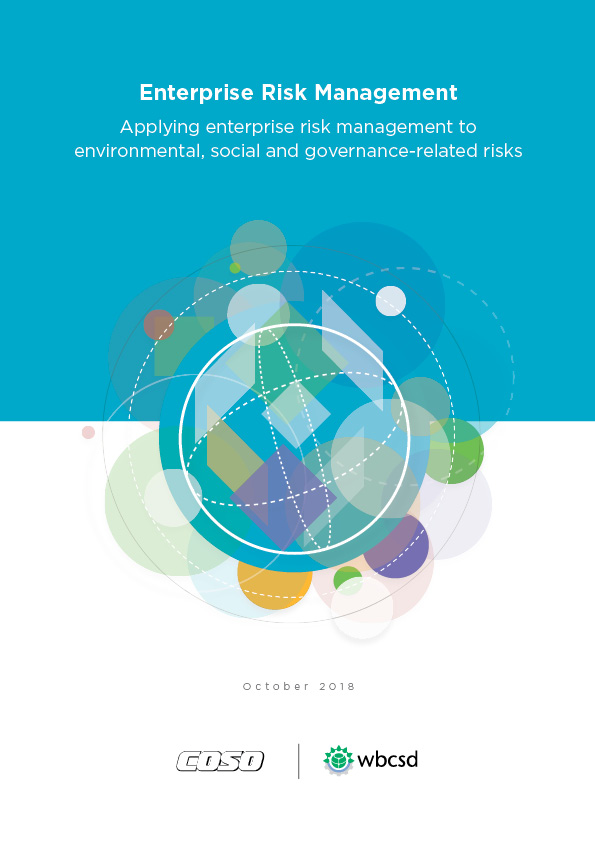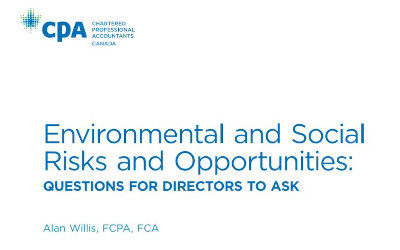
Risk management
The board has a duty to oversee risk management and internal control processes, this should include the integration of environmental, social and governance information.
Risk management is about doing good business, and on a basic human level, it is about survival. Business should be aware of all potential ESG-related risks and should be doing more to bring these risks into the conversation.
It is important that the board instils the appropriate culture to manage ESG-related risk and opportunity to ensure business resilience over the long-term. When considering existing board responsibilities such as strategy development, the board should reflect upon the potential implications of a wider range of risks that may impact the achievement of business objectives.
The board, where necessary, should challenge management to ensure it is considering these issues, but to do this, the boards needs to be aware and abreast of these larger and systemic sustainability challenges.

“‘I think risk assessment in the context of ESG, is critically important and a factor that the board can’t overlook. And so also during the course of strategy development it is just as important to look at ESG on the risk side of strategy development, as it is on the opportunity side”
WBCSD – COSO Risk management guidance

Entities, including businesses, governments and non-profits, face an evolving landscape of environmental, social and governance (ESG)-related risks that can impact their profitability, success and even survival. Given the unique impacts and dependencies of ESG-related risks, WBCSD partnered with the Committee of Sponsoring Organizations of the Treadway Commission (COSO) to develop guidance to help entities better understand the full spectrum of these risks and to manage and disclose them effectively.
This guidance is designed to help risk management and sustainability practitioners apply enterprise risk management (ERM) concepts and processes to ESG-related risks. In particular it helps companies to consider other methods of assessment and prioritization, looking beyond impact and likelihood to consider business adaptability, vulnerability, the interconnectivity between risks and the speed of on-set to support a more holistic view of risk management and understand the potential impacts on achievement of business strategy and objectives.
The full guidance, Applying Enterprise Risk Management to Environmental, Social and Governance-related Risks can be downloaded here.
Questions to the Board

We have collated a series of questions for both board directors and for executive management, designed to be used as prompts for discussion. The questions are intended to help organizations further integrate environmental and social considerations into the existing governance arrangements and decision-making processes within the organization.
There are a series of questions for the board to ask itself or consider in boardroom discussions and a series of questions for the board to collectively ask management to ensure the considerations are embedded in the business operations. Download the questions using the link below.
Training opportunities
To support our implementation and engagement activities on enterprise risk management, WBCSD is convening board directors to provide them with further knowledge and information on how the board can improve the enterprise risk management process and understand the potential systemic risks that may impact the achievement of business strategy and objectives.
The WBCSD-COSO guidance was awarded ISAR Honour at the 36th meeting of the intergovernmental working group of experts on international standards of accounting and reporting. Additionally, attending an in-person or virtual workshops will entitle participants to CPD credits, our training resources have recently been accredited.
To find out more or discuss upcoming workshops, please contact risk@wbcsd.org
Case studies
Resources
We have curated a list of resources that may be useful to board directors, this is not intended to be an exhaustive list, but rather an example of further reading that can be done to enhance board awareness of key environmental, social and governance considerations.
If there are any resources that you think are missing, or that we should refer to, please do not hesitate to email us.
“Net-Zero” Debunked
Earth on Board & Deloitte
An enhanced assessment of risks impacting the energy system
WBCSD & KPMG
Environmental and social risks and opportunities: Questions directors should ask
CPA Canada
Growing ESG Risks: The Rise of Litigation
Baker McKenzie
Board Toolkit
Chapter Zero
Dynamic Risk Assessment: The Power of Four
KPMG

This work is funded by the Gordon and Betty Moore Foundation as part of a conservation and financial markets collaboration.
For more information, please see
http://www.moore.org/FinancialMarkets

Copyright © 2024
World Business Council for Sustainable Development
All rights reserved | Privacy Policy





